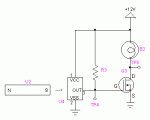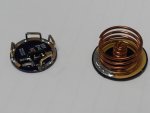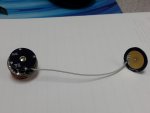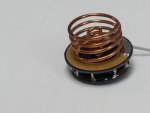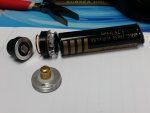- Joined
- Aug 25, 2012
- Messages
- 116
- Points
- 28
Good afternoon everyone!
I am in a project right now in which I am building a circuit that uses a hall effect sensor (linear) to turn on a MOSFET. I've come across the below schematic, and have tried to wire it as shown. I have also tied the opposite side of the resistor to ground (negative battery terminal) still with no joy. I can get all the voltages I'm supposed to, just no forward driving on the MOSFET.

I suspect the 'FET might be the culprit, although I thought I had all the bases covered. It is a logic-level MOSFET with low enough current and voltage to be useful, and 2V should be plenty to forward-drive.
Anyways, the hard data for the components:
Diodes Incorporated AH49E (link)
NXP Semiconductor MOSFET, PMV45EN2 (link)
The schematic, as it is today:

Notes on Above:
The voltage tuning diode has been removed and shorted, so no need to worry about that. It is used to tune the sensitivity of the hall effect component, which will be useful once the circuit works!
The upper left contact farm is power and mechanical switch contacts. It's all VCC, supplied by a single Li-Ion battery, 3.7-4.0 VDC.
"Controlled Circuit Return" would be the case connection.
BONUS: If you help me getting it working, I'll tell you what the circuit is for!!! It is not only laser related but also a component I'm hoping to incorporate in my final this semester.
I am in a project right now in which I am building a circuit that uses a hall effect sensor (linear) to turn on a MOSFET. I've come across the below schematic, and have tried to wire it as shown. I have also tied the opposite side of the resistor to ground (negative battery terminal) still with no joy. I can get all the voltages I'm supposed to, just no forward driving on the MOSFET.
I suspect the 'FET might be the culprit, although I thought I had all the bases covered. It is a logic-level MOSFET with low enough current and voltage to be useful, and 2V should be plenty to forward-drive.
Anyways, the hard data for the components:
Diodes Incorporated AH49E (link)
NXP Semiconductor MOSFET, PMV45EN2 (link)
The schematic, as it is today:
Notes on Above:
The voltage tuning diode has been removed and shorted, so no need to worry about that. It is used to tune the sensitivity of the hall effect component, which will be useful once the circuit works!
The upper left contact farm is power and mechanical switch contacts. It's all VCC, supplied by a single Li-Ion battery, 3.7-4.0 VDC.
"Controlled Circuit Return" would be the case connection.
BONUS: If you help me getting it working, I'll tell you what the circuit is for!!! It is not only laser related but also a component I'm hoping to incorporate in my final this semester.
Attachments
Last edited:


